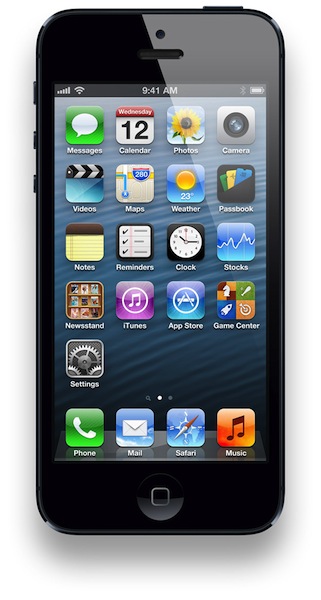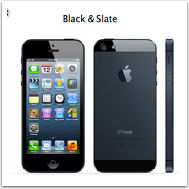First impressions…
October 21, 2012 1 Comment
 I like it…
I like it…
I like it a lot actually!
Whilst it took me awhile to track one down, as stocks are limited and the online reservation system is like a daily lottery and as always the house mostly always wins. I got an email from Apple saying one was ready to pick up this morning so off I went.
Upon opening the box at the Apple store, I checked the phone’s finish for any of the defects reported by other purchasers online. The Genius loaded in my new nano-sim and I went through basic setup of the phone to confirm it was working and took it home. There I unboxed it and took a closer look and took of the plastic shipping protectors front and back and I’m suitably impressed by the features, look and feel of this phone. The longer screen didn’t feel strange in my hand at all and apparently Apple went to great lengths to make sure this would be so and was a major factor in the overall dimensions.
After loading up my config and files etc I started to explore some of the new features and play with some of my familiar apps but then I had to get it to download all my music from iCloud and then I tried out the new designed earbuds. What can I say WOW! they have really designed some great sounding earbuds and these are stock! The bass is clear and powerful with the high end crisp and not overbearing. I normally use Klipsch or Ultimate Ears as my choice of earbud and these easily keep up with much more expensive buds. You can also buy these online for under $35 from the Apple store here.
 I had a play with Siri, my previous phone the iPhone 4 does not have Siri but my iPad 3 does so I had used it before. I’m looking forward to using Siri a bit more day to day as I carry and use my iPhone all the time and I’ve taken the time to set up various contacts with the necessary info Siri can use so it should make some functions easier.
I had a play with Siri, my previous phone the iPhone 4 does not have Siri but my iPad 3 does so I had used it before. I’m looking forward to using Siri a bit more day to day as I carry and use my iPhone all the time and I’ve taken the time to set up various contacts with the necessary info Siri can use so it should make some functions easier.
Getting back to the overall design, the new screen size coupled with the Retina display looks just fantastic and some 720 videos in full widescreen format with that display just looked fantastic.  Having the extra row of icons on each home screen is welcomed but takes some getting used to. I think perhaps the icons need to be made a tad smaller as it looked a bit crowded. Email and Twitter/Facebook on the larger screen is also easier to use. I’ve noticed not all apps have been updated for the new display yet and center on the screen or stretch where needed so this isn’t really an issue at this point. The new aluminum back is much better than the glass back of the 4 and 4s model and gives me more confidence I’m not going to smash my phone if I accidently drop it. However the slightly lighter weight, the change in size makes it feel slightly heavier than a 4 but also lighter at the same time if that makes sense.
Having the extra row of icons on each home screen is welcomed but takes some getting used to. I think perhaps the icons need to be made a tad smaller as it looked a bit crowded. Email and Twitter/Facebook on the larger screen is also easier to use. I’ve noticed not all apps have been updated for the new display yet and center on the screen or stretch where needed so this isn’t really an issue at this point. The new aluminum back is much better than the glass back of the 4 and 4s model and gives me more confidence I’m not going to smash my phone if I accidently drop it. However the slightly lighter weight, the change in size makes it feel slightly heavier than a 4 but also lighter at the same time if that makes sense.
The headphone jack has been moved to the bottom alongside 2 speakers and the new lightning dock connector. The move of the headphone jack is a welcome change and I always found it awkward with the cable sticking out of the top rather than the bottom.  This should make dock designs much nicer.
This should make dock designs much nicer.
Speaking of this new connector “Lightning” which has been the suject of a lot of critisism and controversy and I can honestly understand why Apple changed it now I have one as it’s easier to insert, works upside down and is much smaller which makes it easier to make the phone thinner as much as smaller. The change has made some people very angry as they will have to buy adapters and new accessories which is understandble but you have to draw a line in the sand somewhere and I guess 2012 is it. The old connector was bulky and a pain in the butt to connect sometimes especially with aftermarket accessories. I like the new connector and I like being able to stick it in upside down!
 You can purchase extra lightning to USB cables as well as a short original 30 pin dock plug to lightning converter. There is also a small dock adapter available as well but this is currently in limited supply and stock is scares in AU. An example of these are right:
You can purchase extra lightning to USB cables as well as a short original 30 pin dock plug to lightning converter. There is also a small dock adapter available as well but this is currently in limited supply and stock is scares in AU. An example of these are right:
There is an A6 chip in this beast which is noticeable when loading the camera, speaking of which is 8mp on the back camera and 1.2mp on the FaceTime front facing camera. I’ve yet to take any decent pictures with it but from all reports I’ve seen it’s pretty good. There has been a small issue of purple haze around some outdoor and extreme lighting conditions but these shall remain to be seen.
 Overall so far I’m very impressed with the phone as a whole. The new features in iOS 6 also add to the overall positive experience I’ve had so far. I have however noticed a few little issues here and there such as the phone sometimes not being recognised in iTunes first time, and battery life seems a little more excessive than my iPhone 4 so far but I’ll give the phone a day or 2 to settle into my normal usage pattern and then re-assses this.
Overall so far I’m very impressed with the phone as a whole. The new features in iOS 6 also add to the overall positive experience I’ve had so far. I have however noticed a few little issues here and there such as the phone sometimes not being recognised in iTunes first time, and battery life seems a little more excessive than my iPhone 4 so far but I’ll give the phone a day or 2 to settle into my normal usage pattern and then re-assses this.
I wasn’t impressed when I asked about a cover for it at the Apple store to which I was told they will be available in November. Luckily I had purchased a cheap bumper case for it on Ebay a few days earlier which will suffice for now. The new lottery reservation system sucks the big one royally I must say. The old system of putting a select number of phones up for reservation each day on a first come first serve basis was much better cause at least you knew if you got one or not. In fact their overall stock control policy is far from ideal. Whilst I think their marketing is fantastic and obviously works, their arrogance at allowing stock out in a trickle to keep the hype going is an ethos that will probably bite them in the bum in the long term.
Stay tuned for part 2 which will come in a few days after the initial shiney impressions wear off.


















You must be logged in to post a comment.